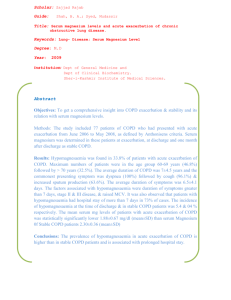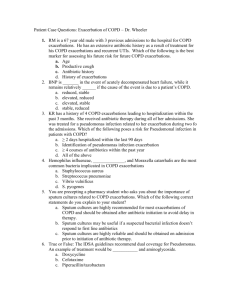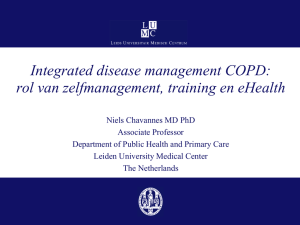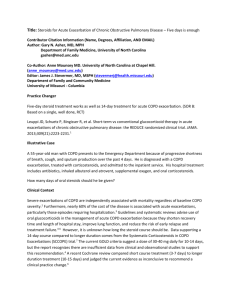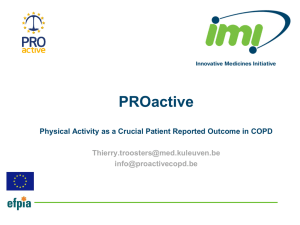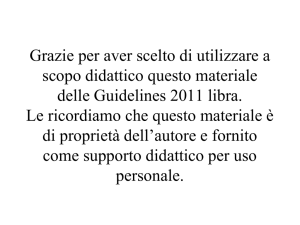COPD and Home Monitoring
advertisement
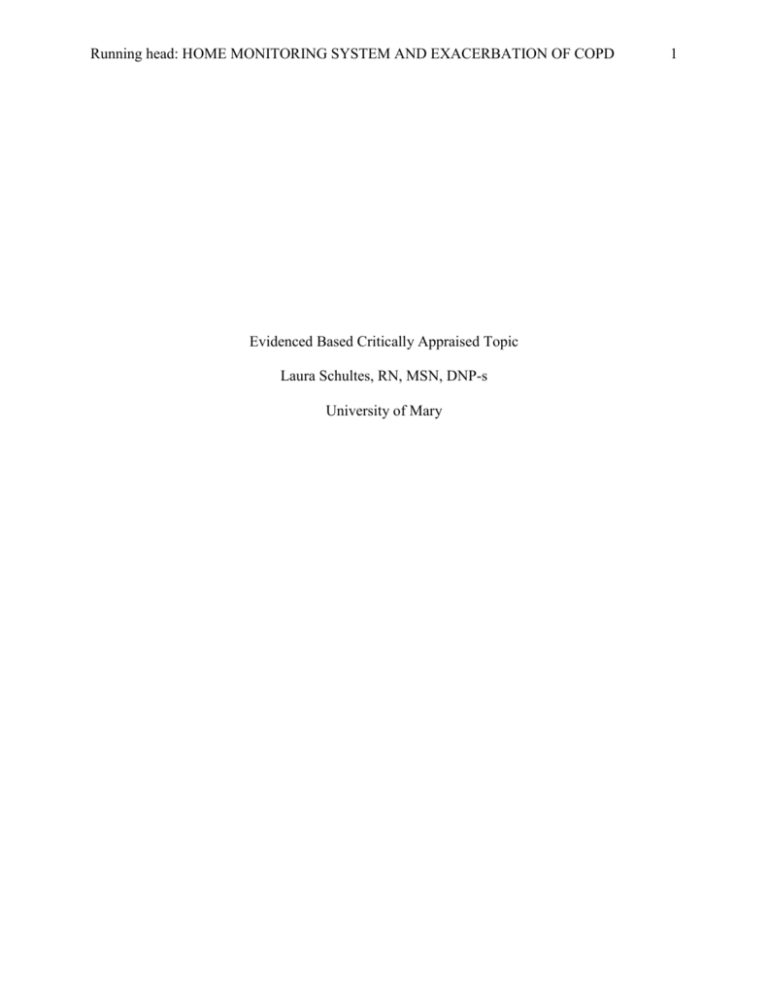
Running head: HOME MONITORING SYSTEM AND EXACERBATION OF COPD Evidenced Based Critically Appraised Topic Laura Schultes, RN, MSN, DNP-s University of Mary 1 HOME MONITORING SYSTEM AND EXACERBATION OF COPD 2 Case Presentation Fifty-six year old C.M. presents to the clinic for a post-hospital examination. C.M. has been hospitalized three times in the last year with acute exacerbation of COPD. C.M. was diagnosed five years ago with COPD and continues to smoke. C.M. voices that she will exhibit symptoms several weeks prior to being hospitalized, but is never sure if they are serious enough to be seen or what to do to prevent the exacerbations. C.M. is inquiring if there is a way she could call the clinic initially when symptoms worsen to help determine if she should be seen or other recommendations that could help prevent another hospitalization. Clinical Question in PICO Format How does home monitoring compare to those that do not utilize home monitoring in preventing acute exacerbations for COPD patients? Scholarly Articles Cruz, J., Brooks, D., & Marques, A. (2014). Home telemonitoring effectiveness in copd: a systematic review. The International Journal of Clinical Practice, 68(3), 369-378. Ding, H., Karunanithi, M., Kanagasingam, Y., Vignarajan, J., & Moodley, Y. (2014). A pilot study of a mobile-phone-based home monitoring system to assist in remote interventions in cases of acute exacerbation of copd. Journal of Telemedicine and Telecare, 20(3), 128-134. Summary and Appraisal of Key Evidence Article One Evan’s hierarchy of evidence was used for the evaluation of the scholarly articles (Spector, 2010). According to this evaluation tool, this article received a level of excellent since it was a systematic review of the literature. The validity is strong as this was a systematic review HOME MONITORING SYSTEM AND EXACERBATION OF COPD 3 of the literature. The authors of this study performed an electronic literature search using Medline, Embase, B-on and Web of Science between August 2012 and July 2013. Nine articles were included after exclusion and inclusion criteria were examined. This study found a trend to reduced healthcare costs in the telemonitoring group. Two of the articles showed a reduced number of exacerbations and improved quality of life. The study concluded that although it appears that home telemonitoring has a positive effect in reducing respiratory exacerbations, hospitalizations and improving quality of life, the evidence is limited and further research is needed. Strengths include the systematic nature of the review. Weakness or limitations include the limited number of included articles. There are many opportunities that arise from this study including the potential to decrease healthcare costs and improve quality of life for COPD sufferers. The treats could include limited organizational resources to implement such a program for all COPD patients and the lack of research in this area. Article Two This study, using Evan’s hierarchy of evidence, received a level of good (Spector, 2010). The validity is good, although there was no randomization, which does leave room for bias. There were eight participants in this study who used mobile phone to record observed COPD symptoms including vital signs, shortness of breath, cough, heart rate, SpO2 and body temperature. The data was stored in a remote server and allowed providers to view graphs to show the variations of symptoms over time. The providers made daily calls and those with acute exacerbations were treated at home. This study showed that major symptoms decreased significantly after being treated at home and within two weeks the patients returned to baseline. This study showed fewer hospital admissions, fewer emergency department visits and fewer clinic visits within a six-month periods. The study concluded that there is potential for home HOME MONITORING SYSTEM AND EXACERBATION OF COPD monitoring of respiratory symptoms and early intervention of acute COPD exacerbations. Strengths of this study were the significant results showing a potential for home monitoring of COPD symptoms. Weakness or limitations include the small sample size and lack of randomization. The opportunities for decreased healthcare costs were demonstrated in this study. The threats include the ability to reproduce the findings in a different health care organization. Clinical Bottom Line Both of the scholarly articles reviewed were of high quality, validity and showed a benefit to using home monitoring for patients with COPD. With the current evidence reviewed and the documented impact from COPD exacerbations, there appears to be more benefit than risks associated with home monitoring and should be a recommendation for patients with frequent acute exacerbations to help prevent recurrent hospitalizations. Implications for Practice Due to the severity and impact that COPD has on health care organizations, it is vital to determine ways to increase health and decreased health care utilization. These two studies demonstrate one of the ways this can be accomplished. Use of home monitoring for acute exacerbations of COPD has the potential to help reduce health care costs by preventing hospital readmissions, clinic visits and emergency department visits. 4 HOME MONITORING SYSTEM AND EXACERBATION OF COPD 5 References Cruz, J., Brooks, D., & Marques, A. (2014). Home telemonitoring effectiveness in copd: a systematic review. The International Journal of Clinical Practice, 68(3), 369-378. Ding, H., Karunanithi, M., Kanagasingam, Y., Vignarajan, J., & Moodley, Y. (2014). A pilot study of a mobile-phone-based home monitoring system to assist in remote interventions in cases of acute exacerbation of copd. Journal of Telemedicine and Telecare, 20(3), 128-134. Spector, N. (2010). Evidence-based nursing regulation: a challenge for regulators. Journal of Nursing Regulation, 1(1), 30-36.

